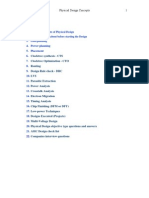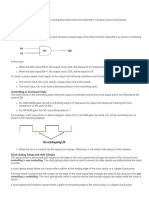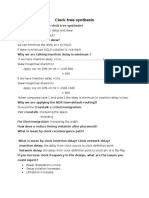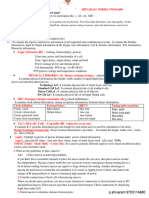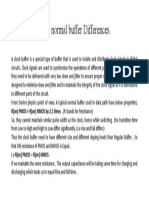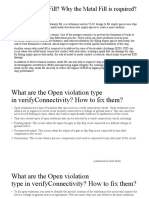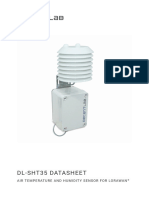100%(2)100% found this document useful (2 votes)
2K viewsFloorplan Summary:: Checks Before Floorplan: Floorplan Steps: Constraints: Floorplan Check List
Floorplan Summary:: Checks Before Floorplan: Floorplan Steps: Constraints: Floorplan Check List
Uploaded by
Sai KumarThe document discusses floorplanning, placement, and clock tree synthesis (CTS) summaries. Some key steps for each are:
Floorplanning includes defining block sizes and shapes, voltage creation, IO placement, adding placement blockages, and adding physical cells. Placement includes coarse placement, legalization, detailed placement, and scan chain reordering. CTS involves routing clock networks to minimize skew based on inputs like the netlist and timing constraints. Checks are done throughout to ensure legalization, timing requirements, congestion controls and other metrics are met.
Copyright:
© All Rights Reserved
Available Formats
Download as PPTX, PDF, TXT or read online from Scribd
Floorplan Summary:: Checks Before Floorplan: Floorplan Steps: Constraints: Floorplan Check List
Floorplan Summary:: Checks Before Floorplan: Floorplan Steps: Constraints: Floorplan Check List
Uploaded by
Sai Kumar100%(2)100% found this document useful (2 votes)
2K views5 pagesThe document discusses floorplanning, placement, and clock tree synthesis (CTS) summaries. Some key steps for each are:
Floorplanning includes defining block sizes and shapes, voltage creation, IO placement, adding placement blockages, and adding physical cells. Placement includes coarse placement, legalization, detailed placement, and scan chain reordering. CTS involves routing clock networks to minimize skew based on inputs like the netlist and timing constraints. Checks are done throughout to ensure legalization, timing requirements, congestion controls and other metrics are met.
Original Title
Untitled
Copyright
© © All Rights Reserved
Available Formats
PPTX, PDF, TXT or read online from Scribd
Share this document
Did you find this document useful?
Is this content inappropriate?
The document discusses floorplanning, placement, and clock tree synthesis (CTS) summaries. Some key steps for each are:
Floorplanning includes defining block sizes and shapes, voltage creation, IO placement, adding placement blockages, and adding physical cells. Placement includes coarse placement, legalization, detailed placement, and scan chain reordering. CTS involves routing clock networks to minimize skew based on inputs like the netlist and timing constraints. Checks are done throughout to ensure legalization, timing requirements, congestion controls and other metrics are met.
Copyright:
© All Rights Reserved
Available Formats
Download as PPTX, PDF, TXT or read online from Scribd
Download as pptx, pdf, or txt
100%(2)100% found this document useful (2 votes)
2K views5 pagesFloorplan Summary:: Checks Before Floorplan: Floorplan Steps: Constraints: Floorplan Check List
Floorplan Summary:: Checks Before Floorplan: Floorplan Steps: Constraints: Floorplan Check List
Uploaded by
Sai KumarThe document discusses floorplanning, placement, and clock tree synthesis (CTS) summaries. Some key steps for each are:
Floorplanning includes defining block sizes and shapes, voltage creation, IO placement, adding placement blockages, and adding physical cells. Placement includes coarse placement, legalization, detailed placement, and scan chain reordering. CTS involves routing clock networks to minimize skew based on inputs like the netlist and timing constraints. Checks are done throughout to ensure legalization, timing requirements, congestion controls and other metrics are met.
Copyright:
© All Rights Reserved
Available Formats
Download as PPTX, PDF, TXT or read online from Scribd
Download as pptx, pdf, or txt
You are on page 1of 5
Floorplan Summary:
Checks Before Floorplan:
Netlist Checks: (floating pins and nets , multi-driven nets , combinational loops ,unconstrained pins, mismatch
pin-count between instances and references.
Floorplan Steps:
Define Size and shape of block -> Voltage Creation ->IO placement ->Add placement blockage -> Adding Power
switch -> Add Physical cells -> placing and qualifying pushdown cells ->creating bounds and regions
Constraints :
Project.tcl (QRC Tech File, Core files ,Setup_lib.tcl , Setup analysis view ,Setup mmmc.tcl )
User_setting.tcl ( Tap cell , physical setting ,set max transition , Voltage area setting ,Placement blockage setting)
Floorplan Check list:
Lib_checks, FT_clock_check, Even Site roe ,First row MX, Sram Spacing ,Sram Finfetgrid , Hard blockage
spacing ,Tcic drc , Violation of endcap , MAPS error.
PLACEMENT SUMMARY
Placement Inputs: (netlist, logical and physical library ,Floorplan def, Design constraints, Timing
constraints , Scan def ,Technology file )
Placement Flow:
Coarse Placement: Rough placement where tool place randomly all the cells in the design , the overlaps and
illeagal positions are ignored.
Legalization: The tool assigns legal location to all the cells and eliminates all the overlaps.
Detailed Placement: Iterative incremental optimization
Scan-Chain Reordering : Inserting DFT scan-chain reordering to improve congestion and Timing.
HFNS: High Fanouts are buffered automatically by the tool
Tie cell addition: To avoid gate-oxide damage , the tie cells connects Std cells directly to Power and Ground.
Placement Targets:
Congestion-Driven Placement
Timing-Driven Placement
Power-Driven Placement
PLACEMENT SUMMARY
Placement Blockages: (hard ,soft and partial)
Fixes after Placement:
Legality Issue : Performs Refine Placement to check all the logics are legally placed and no overlaps.
DRV FIx: Fixing max-transition along data path
Cell Delay : Depends on input transition and output load .
Checks after Placement:
Check Legalization
Check pg connections for all the cells
Check congestion ,Density screens and pin density over maps to make sure they are under control.
Check Min/max- Tran/cap violations
Check whether all Don't-touch cells/nets are preserved.
Check the total utilization of the design
CTS SUMMARY
Inputs of CTS :
Technology file (.tf) ,Netlist, SDC ,Library files (.lib & .lef) ,TLU+ file ,Placement DEF file
Clock specification file which contains Insertion delay, skew, clock transition, clock cells, NDR, CTS tree type, CTS
exceptions, list of buffers/inverters etc...
Checks need to be done before CTS Check :
• Legality Check
• Timing QOR (Setup should be under control)
• Timing DRVs
• High Fanout nets (like scan enable/any static signal)
• Congestion (running CTS on congestion design / design with congestion hotspot can create more congestion and
other issues (Noise/IR) )
Types of clock tree structures (to minimize the skew).
1. H-Tree
2. X-Tree
3. Method of Mean and Median
4. Geometric Matching Algorithms
5. Pi Configuration
6. RC-Tree
CTS SUMMARY
CTS Routing Rules
• Shielding (Techniques in order to avoid crosstalk.We can prevent crosstalk by shielding clock nets with ground wires)
• Non Default Rules (NDR):The user-defined Routing rules apart from the default Routing Rule
• NDRs make the Clock Routes less sensitive to CrossTalk or EM effects
• Double/ Triple Width for avoiding Electromigration
• Double/ Triple Spacing for avoiding Crosstalk
• NDRs will improve Insertion Delay
• Clock Source (The pin that a clock fans out from. (e.g., PLL))
• Clock Sink (All pins that receive the clock signal (FF, latch))
• Clock Tree (The root of a circuit graph for buffering)
• Skew Group (A subset of clock sinks to consider for skew balancing/analysis. By default, all the sinks of a clock tree are in the same
skew group)
• Stop Pins (A leaf pin of a clock tree.)
• Ignore Pins
• Ignore pins are pins on the clock net that will not be considered a sink in any skew group.
• The clock net will be buffered up to the ignore pin but not beyond it.
• Exclude Pins
• Exclude pins are similar to ignore pins, but the clock net will not be buffered up to an exclude pin.
• Through Pins
• Through pins are pins, which would otherwise be considered stop pins, but we want the clock to propagate through them (for buffering
and adding pins to the skew group).
You might also like
- Physical Design CompleteDocument303 pagesPhysical Design CompleteReddicool89100% (49)
- ICC To ICCII Command Mapping v4.5 PDFDocument29 pagesICC To ICCII Command Mapping v4.5 PDFSiva Krishna BandiNo ratings yet
- Netlist Quality ChecksDocument39 pagesNetlist Quality Checkssudhir100% (2)
- SynthesisDocument51 pagesSynthesissudhir100% (2)
- Example TCL Script To Extract Timing Information From A Report - Timing ReportDocument5 pagesExample TCL Script To Extract Timing Information From A Report - Timing Reportsrajece100% (1)
- IC Compiler II Application Options and Attributes: Version K-2015.06-SP4, December 2015Document1,119 pagesIC Compiler II Application Options and Attributes: Version K-2015.06-SP4, December 2015amu100% (1)
- How Does The Clock Skew Violate Setup and Hold Time Contraints? What Are The Common Errors in Constraints?Document11 pagesHow Does The Clock Skew Violate Setup and Hold Time Contraints? What Are The Common Errors in Constraints?Sai KumarNo ratings yet
- Common Commands in ICC2 2 Place StageDocument5 pagesCommon Commands in ICC2 2 Place StageRAZNo ratings yet
- Contoller Replacement InstructionsDocument4 pagesContoller Replacement InstructionsRaj KumarNo ratings yet
- Create Ccopt Skew GroupDocument3 pagesCreate Ccopt Skew GroupsagarNo ratings yet
- PD InputsDocument5 pagesPD InputssandeepNo ratings yet
- Fixing Max Cap and Max Tran ViolationsDocument8 pagesFixing Max Cap and Max Tran Violationsvlsi_asic80% (5)
- Icc, star-RC and PT StepsDocument4 pagesIcc, star-RC and PT StepsSiva Sankar100% (2)
- Explore Your Design With These Useful Single-Line Dbget Scripts in InnovusDocument7 pagesExplore Your Design With These Useful Single-Line Dbget Scripts in InnovusmanojkumarNo ratings yet
- CLock Tree Synthesis PDFDocument50 pagesCLock Tree Synthesis PDFMudit Agarwal100% (2)
- PddesignDocument269 pagesPddesignHT Cooking Channel100% (2)
- Clock Tree Synthesis (CTS) Interview Questions - Vlsi4freshersDocument5 pagesClock Tree Synthesis (CTS) Interview Questions - Vlsi4freshersSindhu Ojha100% (1)
- Clock Tree SynthesisDocument7 pagesClock Tree Synthesiskaushik vkNo ratings yet
- Timing PathsDocument44 pagesTiming PathsMohammed El-Adawy100% (2)
- PD ChecksDocument53 pagesPD ChecksMani Bharath NutiNo ratings yet
- Clock Tree Synthesis: Presentation by Sudhir Kumar MadhiDocument69 pagesClock Tree Synthesis: Presentation by Sudhir Kumar Madhisudhir100% (2)
- Checks To Be Done Before CTSDocument5 pagesChecks To Be Done Before CTSdivyang_pNo ratings yet
- PD - Training Topic: CTS Author: Nilesh Ingale & P. Ravikumar Date:08-11-2012Document90 pagesPD - Training Topic: CTS Author: Nilesh Ingale & P. Ravikumar Date:08-11-2012shresthanagesh100% (1)
- Project ChiptopDocument39 pagesProject ChiptopNikita Patel086No ratings yet
- Eco FlowDocument25 pagesEco Flowprabhakar reddyNo ratings yet
- FP To Route Commands ListDocument4 pagesFP To Route Commands ListNishanth Gowda100% (1)
- What Is Useful Skew and When We Use It ?Document7 pagesWhat Is Useful Skew and When We Use It ?RAZ100% (1)
- Reducing Congestion With IC CompilerDocument9 pagesReducing Congestion With IC Compilermaharajm98100% (1)
- Techniques To Reduce Timing Violations Using Clock Tree Optimizations in Synopsys ICC2Document10 pagesTechniques To Reduce Timing Violations Using Clock Tree Optimizations in Synopsys ICC2Pardhasaradhi Damarla100% (2)
- PD FinalDocument25 pagesPD FinalAnusha ChidagniNo ratings yet
- Vineeth Full PD FlowDocument21 pagesVineeth Full PD FlowprakashNo ratings yet
- PD ChecklistDocument6 pagesPD Checklistsat100% (1)
- Synthesis Interview Questions. - Technology@TdzireDocument6 pagesSynthesis Interview Questions. - Technology@TdziresrajeceNo ratings yet
- PD ReferenceDocument69 pagesPD ReferenceAgnathavasi100% (1)
- HFNSDocument16 pagesHFNSrashmi sNo ratings yet
- Sta Constraints Nandan RoyDocument6 pagesSta Constraints Nandan RoyAvas RoyNo ratings yet
- Understanding What Are Clock Gating Checks and How To Specify, Report and Disable These ChecksDocument7 pagesUnderstanding What Are Clock Gating Checks and How To Specify, Report and Disable These Checksshailesh kumarNo ratings yet
- How Does Clock Reconvergence Pessimism Removal (CRPR) Handle Dynamically Switched Related ClocksDocument4 pagesHow Does Clock Reconvergence Pessimism Removal (CRPR) Handle Dynamically Switched Related ClocksmanojkumarNo ratings yet
- 3.input Files For PDDocument5 pages3.input Files For PDDeepak Kumar S Nadiger100% (1)
- Manoj - Qualcomm Interview QuestionsDocument1 pageManoj - Qualcomm Interview Questionsmanojkumar100% (1)
- CtsDocument6 pagesCtsswathikomati7870No ratings yet
- PrimetimeDocument5 pagesPrimetimeYash Patne100% (1)
- Physical Design QuestionsDocument7 pagesPhysical Design QuestionsstephmoNo ratings yet
- CTS SignoffsemiconductorsDocument7 pagesCTS SignoffsemiconductorsAgnathavasiNo ratings yet
- 10 Ways To Fix SETUP and HOLD Violation - Static Timing Analysis (STA) Basic (Part-8) - VLSI ConceptsDocument10 pages10 Ways To Fix SETUP and HOLD Violation - Static Timing Analysis (STA) Basic (Part-8) - VLSI ConceptsIlaiyaveni IyanduraiNo ratings yet
- Timing Analysis: Path GroupDocument18 pagesTiming Analysis: Path GroupkocchopNo ratings yet
- Set - Clock - Groups During Crosstalk Analysis Are The FollowingDocument9 pagesSet - Clock - Groups During Crosstalk Analysis Are The FollowingSourabh Aditya Swarnkar100% (1)
- 09 PlacementDocument48 pages09 PlacementSujit Kumar100% (2)
- 02 EcoDocument14 pages02 EcoRony MathewsNo ratings yet
- How To Find Floating - Dangling Nets, Pins, IO Ports, and Instances Using Get - DB CommandsDocument4 pagesHow To Find Floating - Dangling Nets, Pins, IO Ports, and Instances Using Get - DB CommandsRuchy ShahNo ratings yet
- Placement, Tool CommandsDocument3 pagesPlacement, Tool CommandsALOK SHUKLANo ratings yet
- Congestion in VLSI Physical Design FLow - VLSI Basics and Interview Questions PDFDocument10 pagesCongestion in VLSI Physical Design FLow - VLSI Basics and Interview Questions PDFsrinathNo ratings yet
- SynthesisDocument41 pagesSynthesisFeroz AhmedNo ratings yet
- PD Flow I - Floorplan - Physical Design, STA & Synthesis, DFT, Automation & Flow Dev, Verification Services. Turnkey ProjectsDocument21 pagesPD Flow I - Floorplan - Physical Design, STA & Synthesis, DFT, Automation & Flow Dev, Verification Services. Turnkey ProjectsShwethNo ratings yet
- PD Flow DocumentDocument4 pagesPD Flow DocumentJaswanth TejaNo ratings yet
- Physical Design CompleteDocument303 pagesPhysical Design CompleteVenkata KarthikNo ratings yet
- 0 PDDocument26 pages0 PDprakashNo ratings yet
- Physical DesignDocument111 pagesPhysical DesignanuhyaNo ratings yet
- ALLtime SynthesisDocument18 pagesALLtime SynthesisAgnathavasiNo ratings yet
- SynthesisDocument18 pagesSynthesissrajeceNo ratings yet
- PD Interview Questions - 1Document38 pagesPD Interview Questions - 1naveenpro2001No ratings yet
- Physical Design.: Performance Area Reliability: PowerDocument185 pagesPhysical Design.: Performance Area Reliability: Powerrajeshpandu828No ratings yet
- Digital VLSI Design: T.Rajeswari (IN1729) Anusha G (IN1727)Document36 pagesDigital VLSI Design: T.Rajeswari (IN1729) Anusha G (IN1727)Sai KumarNo ratings yet
- Inputs of The Cts StageDocument2 pagesInputs of The Cts StageSai KumarNo ratings yet
- What Is Signal Integrity? How It Affects Timing?Document6 pagesWhat Is Signal Integrity? How It Affects Timing?Sai KumarNo ratings yet
- Clock Buffer and Normal Buffer Differences.: R (On) PMOS R (On) NMOS by 2.5 Times - (R Stands For Resistance)Document1 pageClock Buffer and Normal Buffer Differences.: R (On) PMOS R (On) NMOS by 2.5 Times - (R Stands For Resistance)Sai KumarNo ratings yet
- What Is Metal Fill? Why The Metal Fill Is Required?Document8 pagesWhat Is Metal Fill? Why The Metal Fill Is Required?Sai KumarNo ratings yet
- BA AssignmentDocument386 pagesBA Assignmentpriyachand0723No ratings yet
- Java MCQ 17 10 23Document3 pagesJava MCQ 17 10 23ajinkyagorhe130404No ratings yet
- A Micro Project O1Document4 pagesA Micro Project O1Vrushabh HuleNo ratings yet
- Compiler Design - Parser Design With Lex and YaccDocument8 pagesCompiler Design - Parser Design With Lex and YaccDelfim MachadoNo ratings yet
- Full SQL UpdatedDocument273 pagesFull SQL UpdatedAmeet ChendiyekarNo ratings yet
- Networking Notes PDFDocument30 pagesNetworking Notes PDFMahi MudgalNo ratings yet
- CUSTOMDocument40 pagesCUSTOMGoutham NarayananNo ratings yet
- AryanDocument1 pageAryanastropragya11No ratings yet
- 22522-2019-Winter-Model-Answer-Paper (Msbte Study Resources)Document28 pages22522-2019-Winter-Model-Answer-Paper (Msbte Study Resources)Om ChandwadkarNo ratings yet
- 15A04704 Data Communications & NetworkingDocument2 pages15A04704 Data Communications & NetworkingKumar ChandrasekharNo ratings yet
- Assignment CDocument37 pagesAssignment CLucyNo ratings yet
- Finite Automata and Turing Machines: Frank StephanDocument50 pagesFinite Automata and Turing Machines: Frank StephanAbhishekSharmaNo ratings yet
- 08 Web Protection1,3Document27 pages08 Web Protection1,3fhernandez.cmasxalapaNo ratings yet
- Binary NumbersDocument50 pagesBinary NumbersMarjohn Dagohoy SaquinNo ratings yet
- Baseband - WikipediaDocument4 pagesBaseband - WikipediaMubashir AliNo ratings yet
- Cloud Native 5G Core Samsung 5G Core Volume 2Document16 pagesCloud Native 5G Core Samsung 5G Core Volume 2ALEXANDRE JOSE FIGUEIREDO LOUREIRO100% (1)
- 2 Product Specifications: 2-1 Fashion FeatureDocument4 pages2 Product Specifications: 2-1 Fashion FeatureVictorManuelBernalBlancoNo ratings yet
- Solid Principles in Spring Boot ApplicationsDocument8 pagesSolid Principles in Spring Boot ApplicationsJordan KONTIONo ratings yet
- Unit-3 PPT NotesDocument68 pagesUnit-3 PPT Notesharshit aggarwalNo ratings yet
- 3 - Perfect SecrecyDocument59 pages3 - Perfect SecrecyTam KiếmNo ratings yet
- Tle Last TopicDocument1 pageTle Last TopicCharles Kenn MantillaNo ratings yet
- Dell Latitude E6420 Beep Codes Diagnostic IndicatorsDocument3 pagesDell Latitude E6420 Beep Codes Diagnostic IndicatorsrayNo ratings yet
- Eco Manager Quick Start Guide For Windows 7/Vista/XP/2000: You CanDocument49 pagesEco Manager Quick Start Guide For Windows 7/Vista/XP/2000: You CanEd ArenasNo ratings yet
- Google Cloud Computing Foundations M2 - Start With A Solid Platform v3Document57 pagesGoogle Cloud Computing Foundations M2 - Start With A Solid Platform v3Nohelia Luz Jiménez ValenzuelaNo ratings yet
- 1.4.2 Introduction To Networks - Common Types of NetworksDocument4 pages1.4.2 Introduction To Networks - Common Types of NetworksCristian MoralesNo ratings yet
- Decentlab DL SHT35 DatasheetDocument16 pagesDecentlab DL SHT35 Datasheeteugen.lok0813No ratings yet
- Predicting Cyberbullying in Social Media Using Machine LearningDocument7 pagesPredicting Cyberbullying in Social Media Using Machine Learningvinoth1128No ratings yet
- Dh485 Router/B: Panelview800 To SLC or Micrologix SetupDocument15 pagesDh485 Router/B: Panelview800 To SLC or Micrologix SetupjaironleoncioNo ratings yet
- COMP90038 Algorithms and ComplexityDocument15 pagesCOMP90038 Algorithms and ComplexityBogdan JovicicNo ratings yet
